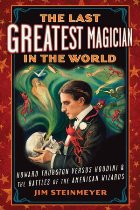 Jim Steinmeyer’s The Last Greatest Magician in the World is part biography, part tell-all, and part ode to the art that is clearly dear to Steinmeyer’s heart. The author begins with little-known biographical detail about the early life as a street urchin and con man of Howard Thurston, a now largely forgotten magician of the early 20th century. He also sprinkles this early section of the book with biographical information of the more famous and better remembered Harry Houdini. He then traces Thurston’s career from a “talker” in the Midway of the 1893 Columbian Exposition through his nearly lethal tour of the Western US to the first successful shows overseas and finally to his wild success in the United States. Steinmeyer has set himself a tough task with this biography about a figure that he both admires professionally, but who is gravely flawed at the same time, and this balancing act sometimes shows in the writing. For example, the sections about Thurston’s early life as the “Nim Kid” clearly fascinated the author but he also seems to want to condemn these shady connections between stage magic and con men. The author has also taken on a monumental task in the second half of the book, trying to situate Thurston in relation to Houdini and to quantify and explain the two men’s relationship. The result is that the book in the second half seems to move away from a biographical mode into something that was more about the history of the magician’s role in culture in the early 20th century. Despite these flaws, the book is still fascinating from beginning to end, and it’s a fabulous peek behind the spangled curtain of the magician at the apex of his art.
Jim Steinmeyer’s The Last Greatest Magician in the World is part biography, part tell-all, and part ode to the art that is clearly dear to Steinmeyer’s heart. The author begins with little-known biographical detail about the early life as a street urchin and con man of Howard Thurston, a now largely forgotten magician of the early 20th century. He also sprinkles this early section of the book with biographical information of the more famous and better remembered Harry Houdini. He then traces Thurston’s career from a “talker” in the Midway of the 1893 Columbian Exposition through his nearly lethal tour of the Western US to the first successful shows overseas and finally to his wild success in the United States. Steinmeyer has set himself a tough task with this biography about a figure that he both admires professionally, but who is gravely flawed at the same time, and this balancing act sometimes shows in the writing. For example, the sections about Thurston’s early life as the “Nim Kid” clearly fascinated the author but he also seems to want to condemn these shady connections between stage magic and con men. The author has also taken on a monumental task in the second half of the book, trying to situate Thurston in relation to Houdini and to quantify and explain the two men’s relationship. The result is that the book in the second half seems to move away from a biographical mode into something that was more about the history of the magician’s role in culture in the early 20th century. Despite these flaws, the book is still fascinating from beginning to end, and it’s a fabulous peek behind the spangled curtain of the magician at the apex of his art.
Reviewed by Katie Richards
